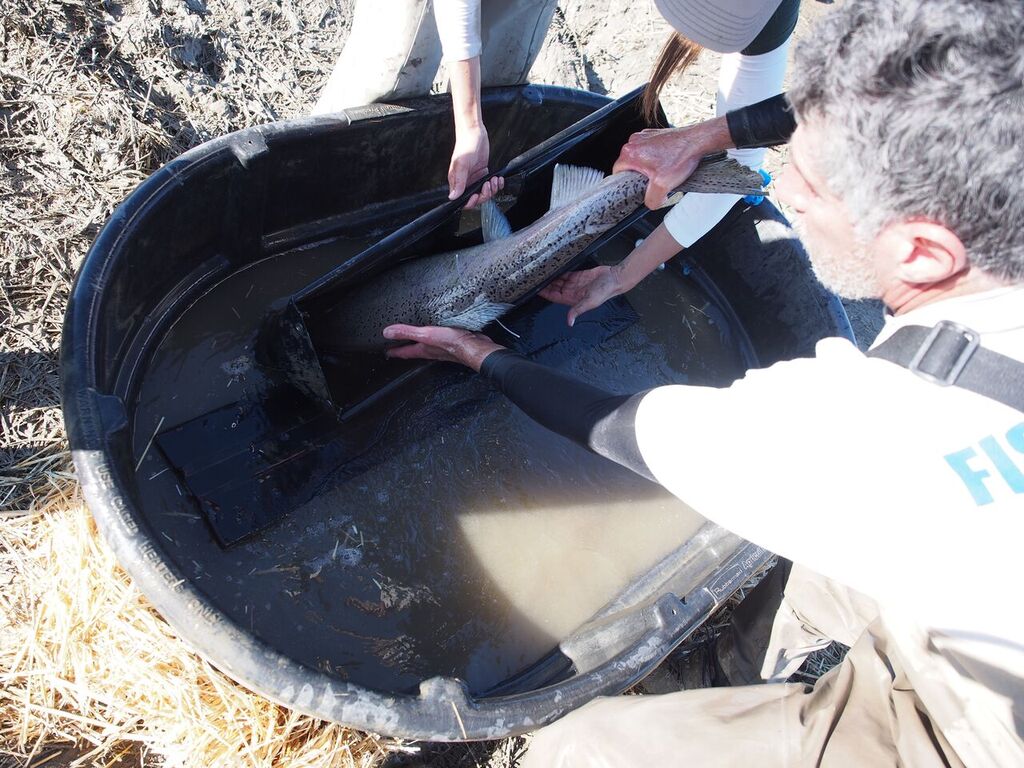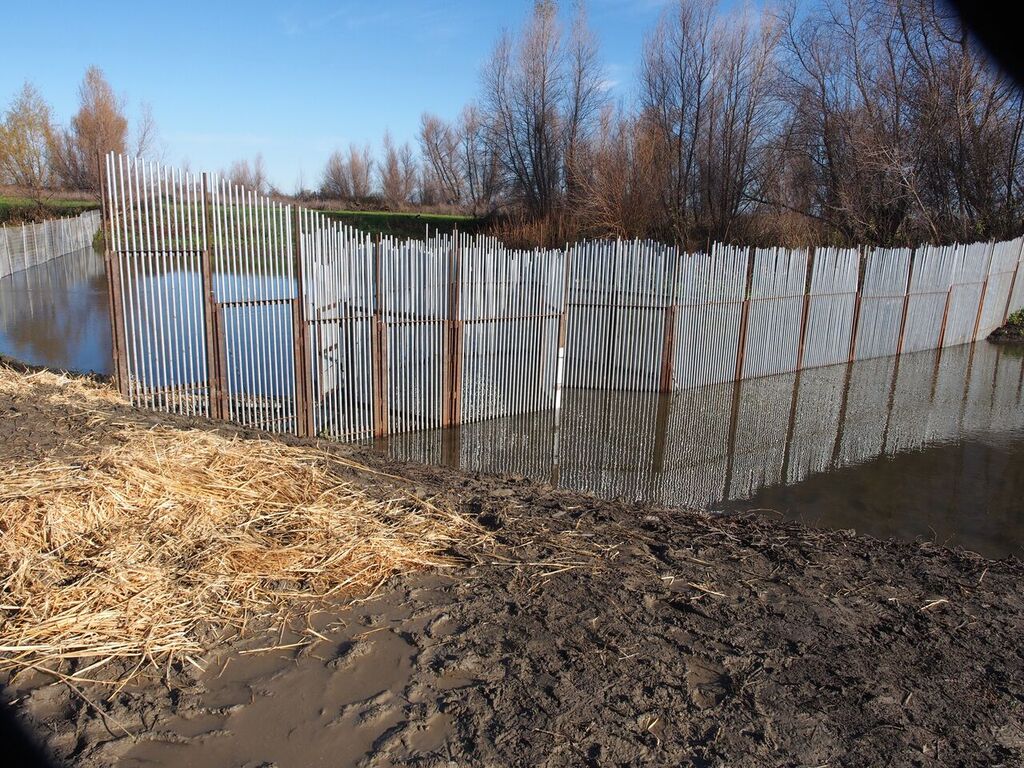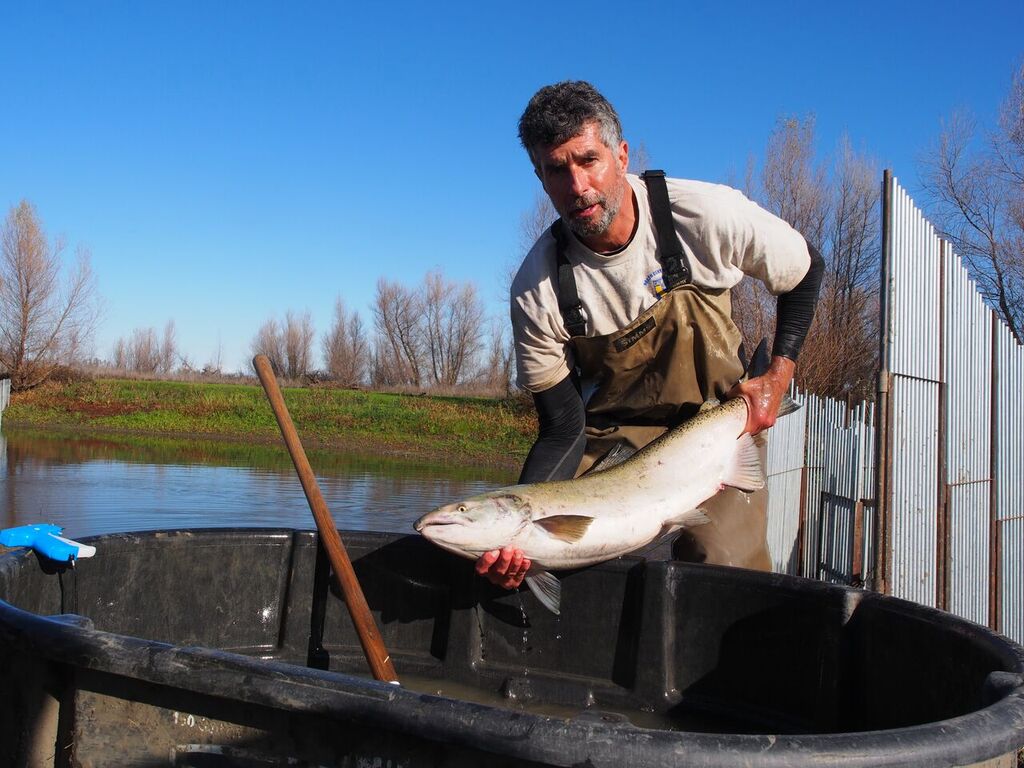As part of the ongoing efforts to help recover salmon in the Sacramento Valley, the California Department of Fish and Wildlife today joined Reclamation District 108 and California Trout in the Yolo Bypass to show the collaboration and efforts that are underway. The news release is shown below.
For Immediate Release:
Dec. 23, 2015
Contact:
Nina Erlich-Williams, Public Good PR
(510) 336-9566, nina@publicgoodpr.com
C: (415) 577-1153
Farmers, Environmentalists and State Agencies Team Up to Rescue Salmon
Woodland, Calif. – Despite four years of record drought, large numbers of salmon are coming back to the Sacramento Valley rivers this winter. Unfortunately some of these salmon are taking wrong turns out of rivers into dead-end drainage canals where they will die unless redirected back into the rivers.
In Yolo Bypass, just 15 minutes from downtown Sacramento, hundreds of large salmon – some weighing up to 30 pounds – are swimming the wrong way up dead end drainage canals. The California Department of Fish and Wildlife (CDFW) is trapping dozens of these fish and trucking them back to the nearby Sacramento River, where they are released to continue the upstream journey to their spawning grounds. Upcoming repairs to the agricultural drainage system should prevent the problem from recurring.
CDFW’s efforts are supported by a diverse group of local farmers, drainage districts and salmon advocates. This past August, farm groups, conservation organizations and government agencies banded together to make repairs to prevent fish from swimming into the Colusa Basin Drain near Knights Landing Outfall Gates. A similar project is planned for next year to block fish at Wallace Weir.
“This model for collaboration, investment, and hard work is vital to the future of the Sacramento Valley and is essential for delivering reliable water supplies to our farms, cities, and the millions of birds migrating along the Pacific Flyway,” says Lewis Bair, program manager of Reclamation District 108. “That’s why our district invested in the Knights Landing upgrade, and why we’re on board to upgrade Wallace Weir in Yolo Bypass to keep these salmon in the river and on the right track in their migration.”
Currently, salmon are blocked from swimming into the Colusa Canal with a temporary fish trap constructed at Wallace Weir as well as a secondary trap in the Colusa Basin Drain itself. CDFW staff operates both trapping sites and have rescued over 450 fall run salmon in the last three weeks. Rescuing fish isn’t always the best decision from a population standpoint, but after evaluation, CDFW determined that assisting would be prudent and this effort has been successful.
“Salmon straying into Colusa Drain is clearly a large problem and it is in everybody’s interest to fix it,” said local rice farmer and landowner John Brennan.
Born in freshwater, salmon travel to the ocean to mature and then return, swimming upstream to their natal streams to reproduce. Canals, levees, dams and other manmade water infrastructure interrupt the normal salmon migrations and are the focus of these collaborative efforts to improve salmon migration, habitat and food supplies. These parties are all working closely to advance a series of projects as part of the Sacramento Valley Salmon Recovery Program.
“To have big adult salmon that have already made the perilous trip to sea and back only to die right before spawning because they take a wrong turn is just plain tragic,” said Jacob Katz of California Trout, a non-profit organization that advocates for the recovery of the state’s threatened native fish. “It’s tragic because it so preventable. It’s time to upgrade our water system and fix this problem.”
Winter run Chinook salmon are listed as a federally endangered species and their population fluctuations can limit water supplies to farmers and cities. Because winter run and fall run Chinook are difficult to distinguish during fishing operations, low numbers of returning winter run salmon have curtailed West Coast commercial fishing in previous years.
“To have adult spawners fail to contribute to the next generation has real economic consequences for California,” said John McManus of the Golden Gate Salmon Association (GGSA), a coalition representing sport and commercial salmon fishermen. “Fishermen get penalized with fishing restrictions when winter run numbers are low, even though fishermen are not the source of the problem.”
Salmon navigate largely by smell but are also attracted by water flow during their return migration. Water operations including reservoir releases and exports from the Delta can confuse signals fish use to migrate back to natal waters. Because the drainage water flowing out of the agricultural canals originates in the Sacramento River basin, it can mix up salmon, luring them off track where they become stranded and die. Prior to CDFW’s fish rescue efforts starting in 2013, the number of salmon lost each year is unknown. Muddy water in winter usually makes it hard to observe fish in the canals.
“This effort provides a second chance for these fish to contribute to the next salmon generation,” said Colin Purdy of CDFW. “If these salmon are not brought back to the river, they will die without reproducing because there is no spawning habitat in these drainage canals.”
In 2013, more than 300 winter and spring-run salmon were rescued from the Colusa Drain.
###







